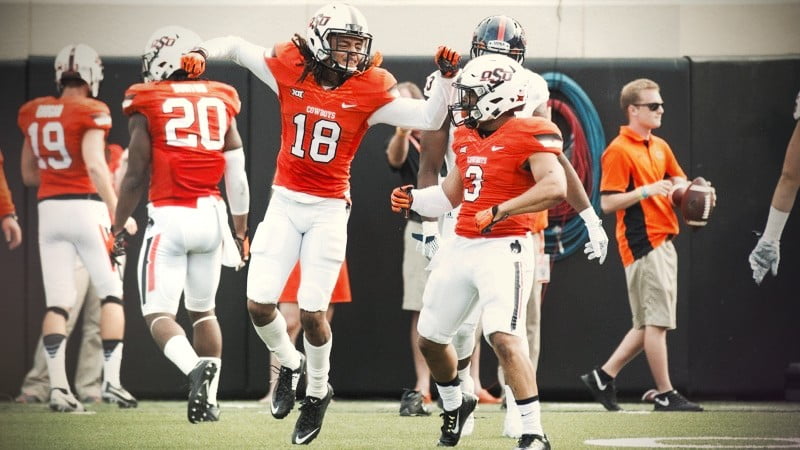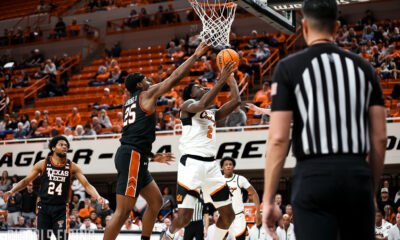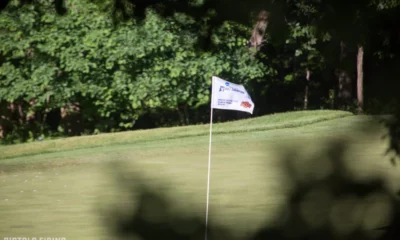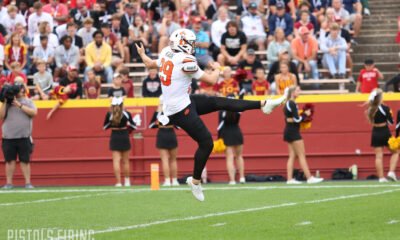Football
Film Study: A Closer Look at Ramon Richards’ Interception

What UTSA was doing
UTSA is lined up in a shotgun formation with four WRs split out wide – two up top, two at the bottom—and the RB to the right of the QB.
When the ball is snapped, the play appears to be a zone read, where the QB reads the right DE to determine if he should hand it off to the RB, keep it himself and run with it, or pass it.
I’m not sure if the zone read handoff was ever really an option on this play, or if the QB/RB was just selling it to bring in the LBs closer to the line-of-scrimmage to open up space for the receivers’ routes.
Often times, if an offense is in the red zone with two WRs to a side, those two receivers will run hi-lo routes. In a hi-lo, the receivers line up close to each other and when the ball is snapped one receiver runs his route short (2-5 yards) while the other receiver runs his a little deeper (7-12 yards).
Ideally, the QB would be able to make a two-level read and, based on the positioning of the LB’s and DB’s, make the appropriate pass.
Looking at the routes of the two WR’s at the bottom, it appears a hi-lo scheme is called. The outside receiver runs a 5-yard slant route, and the inside receiver runs a 7-yard slant route, albeit a sloppy one. However, it looks like at least one of the receivers runs his route incorrectly because when the ball is thrown both receivers are within two yards of each other.

What OSU was doing
Without seeing the play pre-snap, I can’t say for sure what defense OSU is in, but it looks like the Pokes are in a 3-3-5 (sometimes called the 3-3 Stack) alignment, a popular variation of the Nickel defense package where the defense swaps out a lineman for a 5th (hence the name Nickel) defensive back to provide more coverage support.
As with any Nickel defense, the primary purpose of the 3-3-5 is to stop or contain the pass. The 3-3-5 is an especially great defense to use when the offense is having trouble moving the ball on the ground because you know the offense will be forced to throw.
Having a 5th DB on the field opens up for a defensive coordinator to be more aggressive, especially in the red zone. There are numerous stunts a defense could pull while in this formation to give the offensive line fits and get pressure on the QB. In this situation, however, OSU keeps it fairly simple by choosing to only send four defenders after the QB.
Although it might sound crazy, I love watching the OSU defense backed up in the red zone. Why? Well, for one, the field is shortened. As a defense backed up in the red zone, you know the big-gain play is no longer a factor because the offense now has such limited space to make a play. All the defense really has to do is keep the play in front of them and it will have an easier time forcing a turnover, causing a turnover-on-downs, or at the very least, only giving up a FG.
Unless it’s, say, a fade or post route to the back of the end zone, physical safeties like Jordan Sterns can now worry less about a receiver getting behind him and instead focus on running full speed downfield to either deliver a punishing hit or break up a pass (as Sterns did on this play).
Secondly, being in the red zone allows a team like OSU to show off its speed and athleticism. Because the field is shorter, the receivers’ routes are shorter. To compensate for the limited space, a receiver has to make sure his route is crisp and the QB has to make sure he gets the ball out of his hands quick and delivers it accurately.
But when going against a defense as athletic as OSU’s, there’s a good chance there might not even be a window at all for the QB to throw to. The longer it takes for a WR to get open, the longer the offensive linemen have to block and the easier it is for the rushers to get pressure on the QB.
Why this worked for OSU
Up to this point, UTSA was having no luck running the ball so Coach Spencer calls for a 3-3-5 package where everyone except the linemen and Star LB Jordan Burton drop back into coverage. With the ball being on the 15-yard-line, having 7 defenders drop back in zone coverage means there is very little room for error on the QB’s part. Passes made in this situation must be quick and accurate.
With both receivers being in very close proximity to one another on their routes, it makes the defenders’ jobs easier because that’s less space they have to worry about covering.
Without having a clear window to throw through, the QB makes a poor decision after being hurried by Burton and throws into an area being occupied by about three Pokes. From there, Sterns tips the pass and Richards is able to easily haul it in.

-

 Hoops5 days ago
Hoops5 days agoFIU Transfer Arturo Dean Commits to Oklahoma State
-

 Hoops4 days ago
Hoops4 days agoTexas Tech Transfer Robert Jennings Commits to Oklahoma State
-

 Golf5 days ago
Golf5 days agoOSU Freshman Preston Stout Sinks Long Putt to Earn Share of Big 12 Title
-

 Football5 days ago
Football5 days agoAustrailian Punter Hudson Kaak Details Transition to Stillwater, Football






